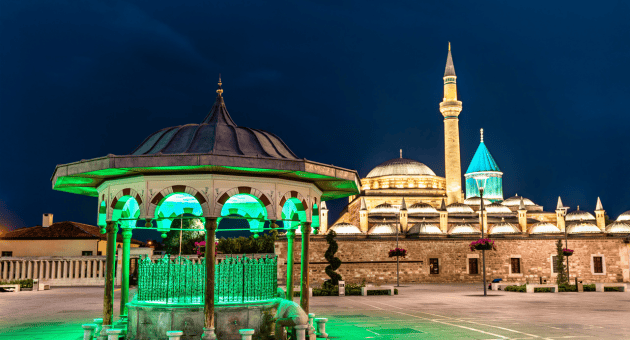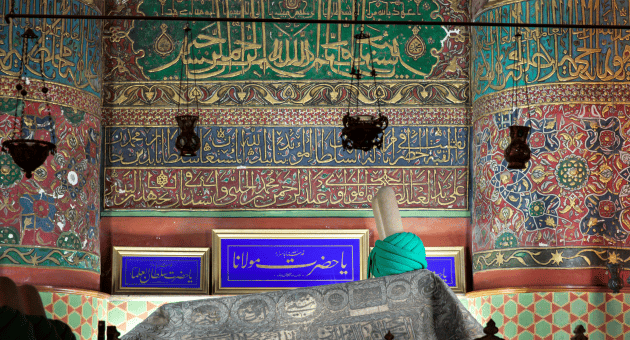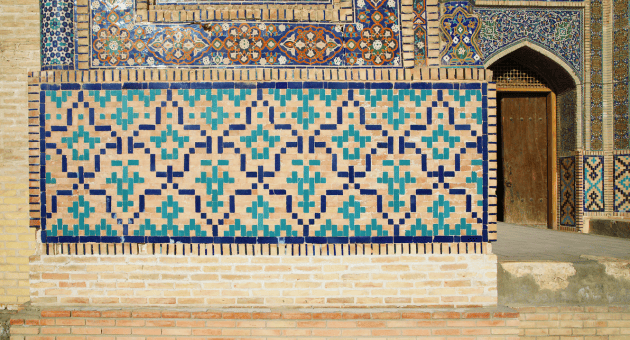Located in the Turkish city of Konya, the Mausoleum of Rumi is a place of great historical and cultural significance. It is the final resting place of the famous 13th-century Sufi mystic and poet, Jalal ad-Din Muhammad Rumi, who is widely regarded as one of the greatest spiritual figures in history.
This article is a guided tour through the Mausoleum and its complex, exploring the life and legacy of Rumi, the history of the Mausoleum itself, and the art and architecture that make it a truly remarkable place to visit.
The Life and Legacy of Rumi

Rumi’s Early Life and Education
Rumi, one of the most famous poets and spiritual figures in history, was born in 1207 in the city of Balkh, in what is now Afghanistan. His father, Bahauddin Walad, was a renowned Islamic scholar and mystic who had a significant influence on his son’s spiritual development.
When Rumi was a child, his family moved to Konya, in present-day Turkey, where he grew up and received his education in Islamic law and theology.
As a young man, Rumi was deeply influenced by the teachings of Sufism, a mystical branch of Islam that emphasizes the direct experience of God through love and devotion. He studied under several Sufi masters, including Shams al-Din Tabrizi, who had a profound impact on his spiritual journey.
It was through his relationship with Shams al-Din Tabrizi that Rumi experienced a spiritual awakening that transformed him from a traditional Islamic scholar to a mystical poet and spiritual leader.
Rumi’s Poetry and Spiritual Teachings
Rumi’s poetry is renowned for its beauty and spiritual depth and continues to be celebrated around the world to this day. He wrote thousands of poems that explore themes of love, devotion, and spiritual transformation. His poems are often filled with vivid imagery and metaphors that convey complex spiritual concepts in a way that is accessible and inspiring to readers.
Rumi’s teachings emphasize the importance of love, compassion, and self-awareness. He believed that the path to spiritual enlightenment was through the cultivation of love and the dissolution of the ego. He taught that by surrendering oneself to the divine and embracing the oneness of all things, one could experience a profound sense of peace and unity with the universe.
Rumi’s Influence on Sufism and Beyond
Rumi’s influence on Sufism cannot be overstated. His poetry and teachings have had a profound impact on the Sufi tradition, and his message of love and unity has resonated with people of all backgrounds and religions. Today, Rumi is revered as a spiritual guide and his work is studied and celebrated by people around the world.
Rumi’s impact extends beyond the Sufi tradition, however. His poetry has been translated into numerous languages and has inspired countless artists, musicians, and writers. His message of love and unity has become a beacon of hope for people seeking spiritual guidance and inspiration in a world that often feels divided and disconnected.
Despite living more than 800 years ago, Rumi’s teachings continue to be relevant and inspiring to people of all ages and backgrounds. His legacy as a poet, mystic, and spiritual leader is a testament to the enduring power of love and the human spirit.
The Mausoleum of Rumi: A Historical Overview

The Construction of the Mausoleum
The Mausoleum of Rumi was built shortly after his death in 1273. The original structure was a simple rectangular building with a wooden dome, but over the centuries it was expanded and embellished with additional buildings, courtyards, and mosques.
The Evolution of the Mausoleum Complex
Over the centuries, the Mausoleum complex underwent a number of changes and additions. In the 15th and 16th centuries, during the Ottoman period, new buildings were added to the complex, including a Dervish Lodge and a mosque. In the 19th century, during the reign of Sultan Abdulhamid II, the complex was further expanded, and a new tomb chamber was built over Rumi’s original burial site.
The Mausoleum is a UNESCO World Heritage Site
In 1927, the Mausoleum was declared a national monument by the Republic of Turkey, and in 2008 it was recognized by UNESCO as a World Heritage Site. The Mausoleum is considered to be an outstanding example of Islamic architecture and a testament to the spiritual legacy of Rumi.
A Guided Tour of the Mausoleum Complex

The Entrance and Courtyard
The Mausoleum complex is entered through a lofty gateway that leads into a large courtyard. The courtyard is surrounded by a series of buildings and has a beautiful central fountain. Visitors are often greeted by Sufi musicians playing traditional Turkish music, creating a tranquil and spiritual atmosphere.
The Dervish Lodge and Whirling Ceremony
The Dervish Lodge is the most iconic building in the complex. It is where the Mevlevi Sufi Order, founded by Rumi’s followers, holds their famous whirling ceremony. The ceremony is a form of meditation and devotion and is a truly mesmerizing sight to witness.
The Mausoleum Itself: Rumi’s Tomb and Surrounding Artifacts
The Mausoleum is located in the centre of the complex and is surrounded by a number of rooms and galleries. Visitors can view Rumi’s tomb, which is covered with green velvet cloth and decorated with beautiful calligraphy. The surrounding rooms contain a number of artefacts related to Rumi’s life, including his personal belongings and manuscripts.
The Art and Architecture of the Mausoleum

The Seljuk and Ottoman Influences
The Mausoleum complex is a fascinating example of the fusion of different architectural styles and influences. The Seljuk Turks, who ruled the region in the 12th and 13th centuries, were known for their distinctive brick architecture, while the Ottomans, who came later, favoured more elaborate and decorative styles.
The Use of Calligraphy and Geometric Patterns
The Mausoleum is also renowned for its intricate calligraphy and geometric patterns. These motifs are found throughout the complex, from the walls of the buildings to the decorative elements on Rumi’s tomb. The calligraphy often features verses from Rumi’s poetry, adding to the spiritual atmosphere of the complex.
The Significance of the Mausoleum’s Design
The Mausoleum complex is not just a beautiful work of art, but also a testament to the spiritual legacy of Rumi. The design of the complex, with its courtyards, gardens, and mosques, is meant to create a sense of harmony and balance, reflecting the principles of Sufism.
Conclusion
The Mausoleum of Rumi is a place of great historical, cultural, and spiritual significance. It is a testament to the life and legacy of one of the greatest spiritual figures in history, and a stunning work of art in its own right.
If you have the opportunity to visit Konya, it is an experience not to be missed. Whether you are a student of Sufism, a lover of poetry, or simply someone who appreciates beauty and history, the Mausoleum of Rumi is a journey through history that you will never forget.


